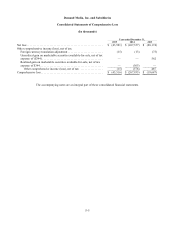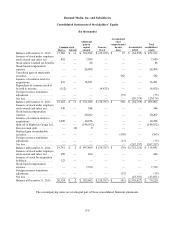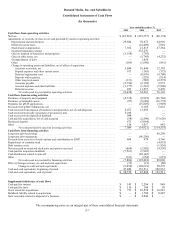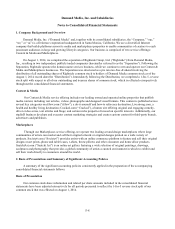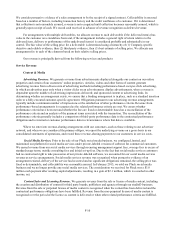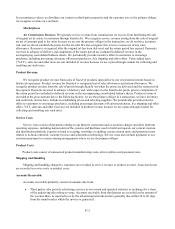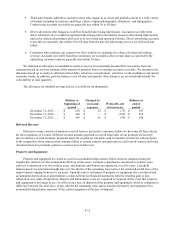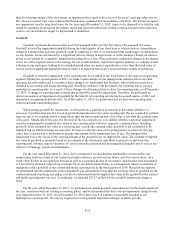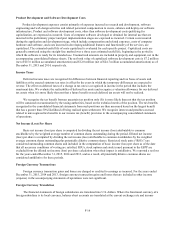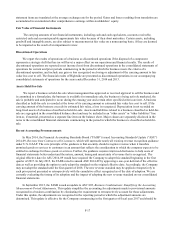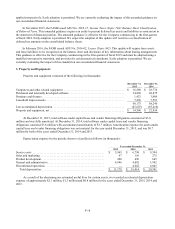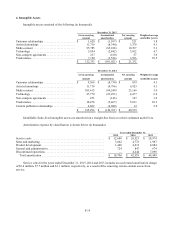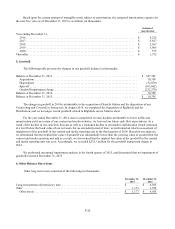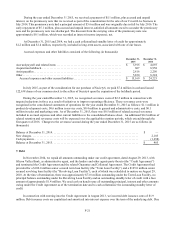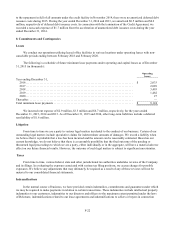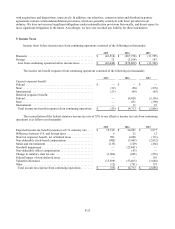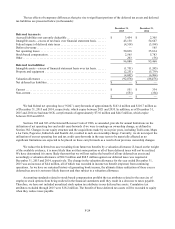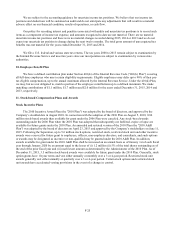Enom 2015 Annual Report Download - page 79
Download and view the complete annual report
Please find page 79 of the 2015 Enom annual report below. You can navigate through the pages in the report by either clicking on the pages listed below, or by using the keyword search tool below to find specific information within the annual report.F-15
Operating Leases
For operating leases that include rent-free periods or escalation clauses over the term of the lease, we recognize
rent expense on a straight-line basis and the difference between expense and amounts paid are recorded as deferred rent
in current and long-term liabilities.
Advertising Costs
Advertising costs are expensed as incurred and generally consist of Internet based advertising, sponsorships, and
trade shows. Such costs are included in sales and marketing expense in our consolidated statements of operations.
Advertising expense was $1.9 million, $2.2 million and $2.5 million for the years ended December 31, 2015, 2014 and
2013, respectively.
Stock-Based Compensation
We measure and recognize compensation expense for all stock-based payment awards made to employees, non-
employees and directors based on the grant date fair values of the awards. Our stock-based payment awards are
comprised principally of restricted stock units and stock options.
For stock-based payment awards issued to employees with service based vesting conditions the fair value is
estimated using the Black-Scholes-Merton option pricing model. For premium-priced stock options with service and/or
performance-based vesting conditions, the fair value is estimated using the Hull-White model. The value of an award
that is ultimately expected to vest is recognized as expense over the requisite service periods in our consolidated
statements of operations. We elected to treat stock-based payment awards with graded vesting schedules and time-based
service conditions as a single award and recognize stock-based compensation expense on a straight-line basis (net of
estimated forfeitures) over the requisite service period. Stock-based compensation expense is classified in the
consolidated statement of operations based on the department to which the related employee provides service.
The Black-Scholes-Merton option pricing model requires management to make assumptions and to apply
judgment in determining the fair value of our awards. The most significant assumptions and judgments include the
expected volatility, expected term of the award and estimated forfeiture rates.
We estimated the expected volatility of our awards from the historical volatility of selected public companies with
comparable characteristics to Demand Media, including similarity in size, lines of business, market capitalization,
revenue and financial leverage. We calculated the weighted average expected life of our options based upon our
historical experience of option exercises combined with estimates of the post-vesting holding period. The risk-free
interest rate is based on the implied yield currently available on U.S. Treasury notes with terms approximately equal to
the expected life of the option. The expected dividend rate is zero as we currently have no history or expectation of
paying cash dividends on our common stock. The forfeiture rate is established based on applicable historical forfeiture
patterns adjusted for any expected changes in future periods.
Under the Demand Media Employee Stock Purchase Plan (“ESPP”), during any offering period, eligible officers
and employees can purchase a limited amount of Demand Media’s common stock at a discount to the market price in
accordance with the terms of the plan. We use the Black-Scholes-Merton option pricing model to determine the fair
value of the ESPP awards granted which is recognized straight-line over the total offering period.
Stock Repurchases
Under a stock repurchase plan, shares repurchased by us are accounted for when the transaction is settled.
Repurchased shares held for future issuance are classified as treasury stock. Shares formally or constructively retired are
deducted from common stock at par value and from additional paid in capital for the excess over par value. If additional
paid in capital has been exhausted, the excess over par value is deducted from retained earnings. Direct costs incurred to
acquire the shares are included in the total cost of the repurchased shares.


